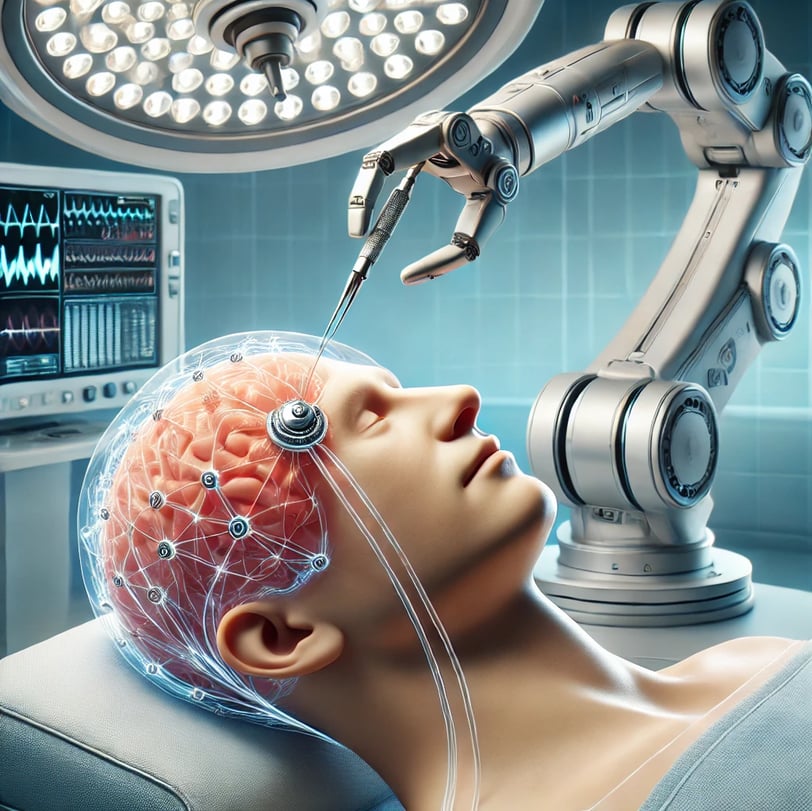Neuralink performs first brain chip implant in a human
Neuralink, a neurotechnology company founded by Elon Musk, recently announced a significant milestone in the field of brain-computer interfaces: the first implantation of a brain chip in a human. This advancement represents an important step in the development of technologies aimed at directly connecting the human brain to electronic devices, paving the way for potential innovations in communication, mobility, and the treatment of neurological conditions.
2/26/20252 min read


What is Neuralink and what is its goal?
Founded in 2016, Neuralink's mission is to create brain-machine interfaces that can help people with neurological disabilities restore lost functions. The technology developed by the company seeks to establish a direct connection between the brain and electronic devices, allowing neural signals to be translated into digital commands. This could benefit patients with paralysis, spinal cord injuries, and other conditions that limit mobility and communication.
Details of the first implant
The groundbreaking procedure was performed in January 2024, and according to Elon Musk, the patient is recovering well and can already interact with the implanted device. The chip, called "Telepathy," is a tiny device that contains ultra-thin electrodes capable of capturing brain signals and transmitting them to an external computer. This system has the potential to allow users to control computers and mobile devices using only their thoughts.
The implant was performed through a minimally invasive surgical procedure using a specialized robot developed by Neuralink to ensure precision and reduce operational risks. The robot, called R1, uses microscopic needles to insert the chip's flexible electrodes into specific regions of the motor cortex, ensuring secure and effective placement.
Technical specifications of the chip
The implanted chip, known as N1, has the following technical characteristics:
Dimensions: Approximately 23 mm in diameter and 8 mm in thickness, comparable to the size of a coin.
Electrodes: Contains about 1,024 ultra-thin flexible electrode channels, allowing for detailed neural signal capture.
Connectivity: The chip communicates wirelessly with external devices via low-latency Bluetooth, eliminating the need for physical connections.
Processing: Includes an embedded microprocessor capable of translating brain signals into digital commands in real-time.
Power Supply: The device is wirelessly rechargeable, using an induction system similar to modern smartphone chargers.
Applications and potential impacts
Neuralink's technology could have various practical applications in the future. Some of the main areas that could be revolutionized include:
Neurological Rehabilitation: People with paralysis could regain the ability to communicate and interact with the digital world.
Control of Electronic Devices: Users may control computers, smartphones, and other devices solely with their thoughts.
Treatment of Neurological Diseases: The chip could assist in treating conditions such as Parkinson's, Alzheimer's, and severe depression.
Cognitive Enhancement: In the long run, Neuralink could enable the enhancement of human cognitive capabilities, allowing faster access to information and increasing human-machine interaction.
Challenges and ethical concerns
Despite the enthusiasm surrounding the technology, the development of brain chips also raises several ethical and technical concerns. Among the challenges faced are the long-term safety of the implant, risks of privacy invasion, and the potential misuse of the technology.
Experts warn of the need for strict regulations to ensure that the devices are used safely and responsibly. Additionally, there are debates about the accessibility of the technology and the risk that only a portion of the population will have access to its benefits, further widening social inequalities.
The future of Neuralink and brain-machine interfaces
The success of the first implant marks just the beginning of a new era in neurotechnology. Neuralink plans to expand its clinical trials and refine its technology, making it increasingly efficient and accessible. If advancements continue at the expected pace, it is possible that in a few years, devices like Telepathy will be available to a wider audience, transforming the way humans interact with technology.
This milestone could represent a major breakthrough in the quest for innovative solutions for neurological disabilities and in expanding the possibilities of the human mind in the digital world.
Explore
Discover diverse topics in one convenient hub.
Connect
Learn
contact@mindstormblog.com
© 2025. All rights reserved.

